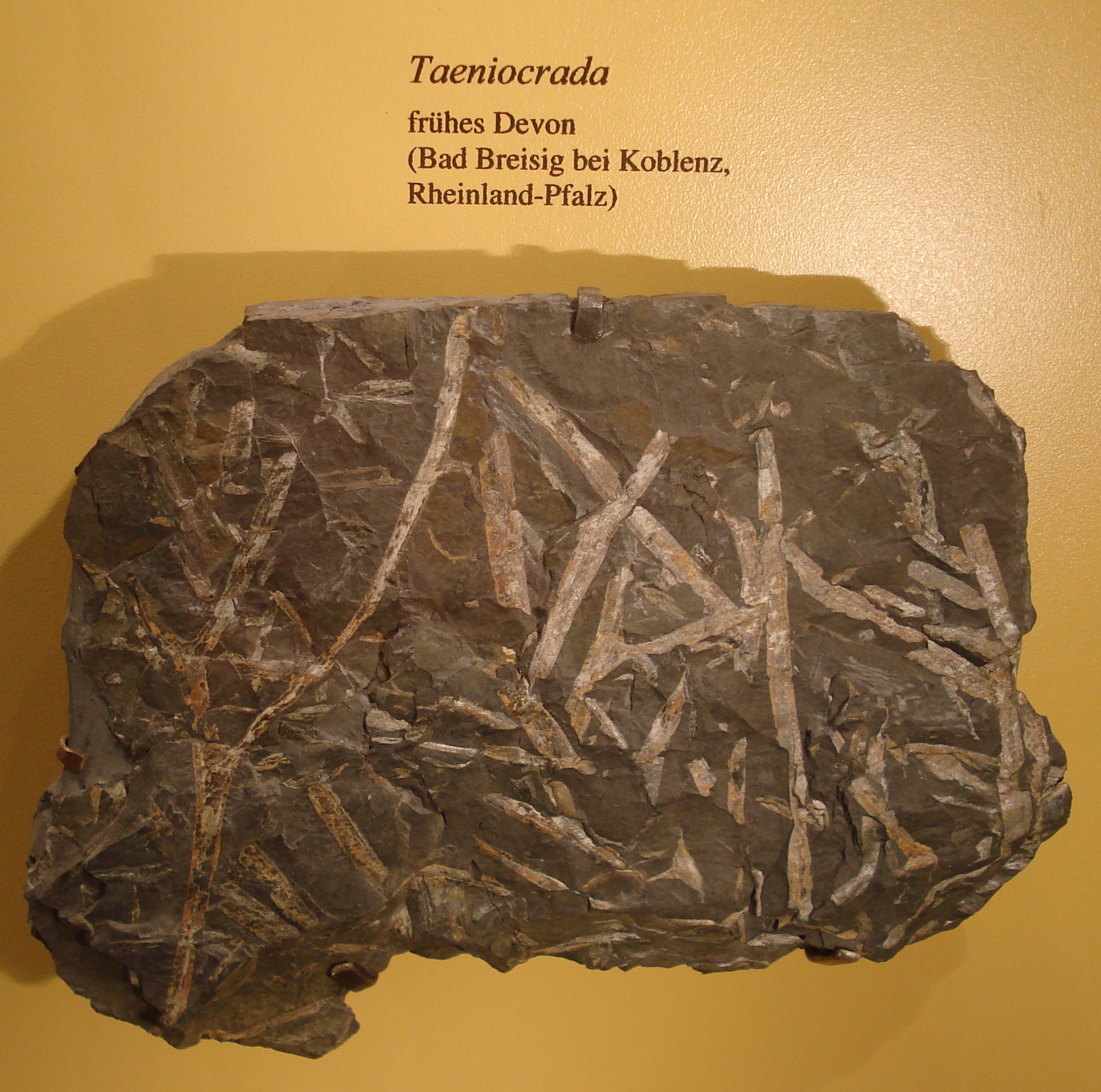Taeniocrada on:
[Wikipedia]
[Google]
[Amazon]
 ''Taeniocrada'' is a
''Taeniocrada'' is a
genus
Genus ( plural genera ) is a taxonomic rank used in the biological classification of living and fossil organisms as well as viruses. In the hierarchy of biological classification, genus comes above species and below family. In binomial nom ...
of extinct plants of Devonian age (). It is used as a form genus for fossil plants with leafless flattened stems which divided dichotomously and had prominent midribs regarded as containing vascular tissue
Vascular tissue is a complex conducting tissue, formed of more than one cell type, found in vascular plants. The primary components of vascular tissue are the xylem and phloem. These two tissues transport fluid and nutrients internally. The ...
s. It has been suggested that some species assigned to this genus were aquatic.
Description
Key features of the original definition of the genus ''Taeniocrada'' were that it possessed leafless flattened stems with prominent midribs which appeared to contain vascular tissues. As more species were added to the genus, its definition became less clear. Three of the better-known species are ''T. decheniana'', ''T. dubia'', and ''T. stilesvillensis''. ''Taeniocrada decheniana'', from the Lower Devonian, had separate fertile stems which repeatedly branched in a dichotomous fashion ending in sporangia between 3 and 7 mm long. A few sporangia were borne on the sides of stems. The species was found in dense stands. It has been suggested that it was aquatic or semi-aquatic because it apparently did not have stomata on the flattened stems. ''Taeniocrada dubia'', from the Lower Devonian, was originally considered to be arhyniophyte
The rhyniophytes are a group of extinct early vascular plants that are considered to be similar to the genus '' Rhynia'', found in the Early Devonian (around ). Sources vary in the name and rank used for this group, some treating it as the class ...
, i.e. a very early vascular plant
Vascular plants (), also called tracheophytes () or collectively Tracheophyta (), form a large group of land plants ( accepted known species) that have lignified tissues (the xylem) for conducting water and minerals throughout the plant. They ...
, but this has been questioned. The central strand appears to have been composed of tubes of differing diameters with helical thickenings which were part of the original cell wall, rather than being produced as the cell matured as would be the case in the xylem
Xylem is one of the two types of transport tissue in vascular plants, the other being phloem. The basic function of xylem is to transport water from roots to stems and leaves, but it also transports nutrients. The word ''xylem'' is derived from ...
of vascular plants.
''Taeniocrada stilesvillensis'', from the Upper Devonian of New York, had stems which divided either into two equal branches (i.e. dichotomously) or so that one branch was more of a 'main stem' than the other (i.e. pseudomonopodially). Ridges along the stem bore hair-like structures. True vascular tissue
Vascular tissue is a complex conducting tissue, formed of more than one cell type, found in vascular plants. The primary components of vascular tissue are the xylem and phloem. These two tissues transport fluid and nutrients internally. The ...
was present.
A further nine species still considered to be part of the genus are listed and in some cases briefly described by Taylor (1986).
Taxonomy
The genus ''Taeniocrada'' has a somewhat complex taxonomic history. It was created by White with the species ''T. lesquereuxii'' for fossils previously regarded as algae but which proved to have vascular tissue. (The date of creation is variously given as 1902, 1903 and 1913.) It was basically a form genus, used for fossil plants with flattened membrane-like stems, which were leafless with a prominent central thickened strand and which showed dichotomous branching. In 1986 Taylor noted that as more species had been added to the genus, the characters it possessed became wider, so that some species hadsporangia
A sporangium (; from Late Latin, ) is an enclosure in which spores are formed. It can be composed of a single cell or can be multicellular. Virtually all plants, fungi, and many other lineages form sporangia at some point in their life cyc ...
which were at the ends of stems (terminal), others had sporangia borne on the sides of stems (lateral). Some species had smooth stems, other had stems with 'emergences' (e.g. spines or hairs). Some were known to have vascular tissue, others not. He concluded that the genus no longer matched any existing description and that its species probably belonged to more than one genus. He also suggested that the flattening of the stems might be artefacts of preservation.
In 1985, Fairon-Demaret created a new genus for fossils previously assigned to ''Taeniocrada'' but which had single lateral sporangia. She transferred ''T. langii'' (named by Stockmans in 1939) to '' Stockmansella langii'', leaving ''Taeniocrada'' for fossil plants with terminal sporangia borne on branched structures.
Phylogeny
Following Taylor (1986), Crane et al. (2004) regard ''Taeniocrada'' as apolyphyletic
A polyphyletic group is an assemblage of organisms or other evolving elements that is of mixed evolutionary origin. The term is often applied to groups that share similar features known as homoplasies, which are explained as a result of conver ...
genus (i.e. a mixture of species with no close common ancestor). Some species may belong to the Rhyniopsida
The rhyniophytes are a group of extinct early vascular plants that are considered to be similar to the genus ''Rhynia'', found in the Early Devonian (around ). Sources vary in the name and rank used for this group, some treating it as the class R ...
as defined by Kenrick and Crane.
References
{{Taxonbar, from=Q7674878 Early Devonian plants Early Devonian first appearances Late Devonian genus extinctions Middle Devonian plants Late Devonian plants Paleozoic life of Ontario Paleozoic life of New Brunswick Paleozoic life of Newfoundland and Labrador Paleozoic life of Quebec Prehistoric plant genera